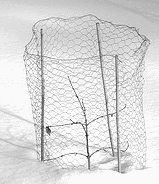Protect Plants from Winter Pests
Winter Protecting Plants from Pests
Prevent damage to your plants from Rodent, Rabbit & Deer
If your area has extended period of snow cover, rabbits, mice or moles may resort to eating the bark of your shrubs and trees. They especially seem to enjoy the young stems of apple, flowering crab, mountain ash, hawthorn, eponymous and viburnum, but they won’t stop there. If they completely remove the bark all the way around the stem or trunk (called girdling) it will kill the plant. Even partial removal of the bark invites disease and insects.
There are a number of ways to protect the trunk. The easiest is using plastic collars that are available at garden centers to protect the trunks and stems of young trees (they are considered “young and tasty” for as much as 10 years). The collars are cut in a spiral fashion or slit so they can be slipped around the trunk. Or use a cylinder of hardware cloth, which is just a flexible wire mesh or woven wire. Whatever you use, it should be secured tight to the ground or even slightly buried, and if possible extend 2 feet above snow depth to keep the rabbits out. For multi branched shrubs, spray with a rodent repellent at least twice through winter, especially in a warm spell. Mixing the repellent with an anti-transpirant may extend the effectiveness.
Deer can also be a problem when food is scarce in snow covered regions. They love to nibble on arborvitae as well as other evergreens in winter, and these large animals can eat a lot. Deer generally live in small “herds” of 3-7, and can decimate your evergreens in a season. “Caging” your evergreens in chicken wire or tall wire fencing will protect them from deer.




